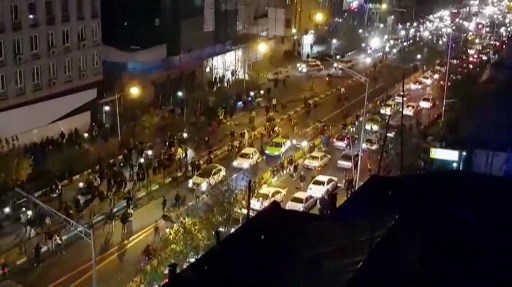
TEHRAN, Iran (AFP) – A fifth night of unrest in Iran saw a policeman killed and sporadic demonstrations in several parts of the country, local media and online users reported Tuesday, despite moves to crack down on the biggest protests against the regime in years.
Small groups of protesters ran through the streets of Tehran on Monday evening, before a heavy police presence restored calm, local agencies said.
The unrest remained focused on provincial towns and cities, although fewer videos on social media suggested less activity in many areas.
State television said one policeman was killed and three others wounded by fire from hunting rifles in the city of Najafabad in central Iran.
The latest demonstrations came despite President Hassan Rouhani’s vow that the nation would deal with “rioters and lawbreakers.”
Ali Shamkhani, secretary of Iran’s Supreme National Security Council, described the unrest — the biggest challenge to the regime since mass protests in 2009 — as a “proxy war against the Iranian people.”
“Hashtags and messages about the situation in Iran come from the United States, Britain and Saudi Arabia,” he told local media.
Iran’s intelligence ministry released a statement saying “instigators” have been identified “and will be dealt with seriously soon.”
The Revolutionary Guards have yet to fully intervene against the protesters, but published photos on Monday of three wanted people and called on the public to report any “seditionist elements.”
Rouhani has tried to play down the unrest, which began over economic grievances in second city Mashhad last Thursday but quickly turned against the Islamic regime as a whole with chants of “Death to the dictator.”
“This is nothing,” Rouhani said in a statement on the presidency website.
“Our nation will deal with this minority who chant slogans against the law and people’s wishes, and insult the sanctities and values of the revolution.”
Pro-regime rallies were held across several towns and cities — reflecting continued support among a large conservative section of society.
A total of 13 people have so far been reported killed in the protests, including six killed by gunfire in the western town of Tuyserkan on Sunday and two others shot dead in the southwestern town of Izeh.
Two more, including a teenage boy, were run down and killed by a fire engine stolen by protesters in the western town of Dorud on Sunday — a story emphasised on state television.
Reporting restrictions remained tight, but videos on social media continued to show widespread anti-government protests in many areas.
‘People have had enough’
A key difference from the last major protest movement in 2009, which began over allegations of election-rigging, is that the protests have not been focused on the capital Tehran and are much more dispersed.
Rouhani came to power in 2013 promising to mend the economy and ease social tensions, but high living costs and a 12 percent unemployment rate have left many feeling that progress is too slow.
The young are most affected, with as many as 40 percent out of work according to analysts, and rural areas particularly hard-hit.
“People have had enough, especially the young people. They have nothing to be happy about,” said Sarita Mohammadi, a 35-year-old teacher in Tehran.
“The situation is far worse in provinces. Agriculture has been destroyed. I know many who have left the north of the country to come to Tehran to work,” she added.
Rouhani acknowledged there was “no problem bigger than unemployment” in a speech on Sunday, and also vowed a more balanced media and more transparency.
Trump calls for change
US President Donald Trump, who has repeatedly criticized Tehran over four days of demonstrations, said it was “time for a change” and that Iran’s people were “hungry” for freedom.
The European Union Monday pushed Iran to guarantee the right to protest and separately British foreign minister Boris Johnson said “the UK is watching events in Iran closely.”
“We believe that there should be meaningful debate about the legitimate and important issues the protesters are raising and we look to the Iranian authorities to permit this,” Johnson said in a statement.
In 2009, authorities ruthlessly put down protests against the re-election of hardliner Mahmoud Ahmadinejad. At least 36 people were killed in 2009, according to an official toll, while the opposition says 72 died. (Agence France-Presse)







